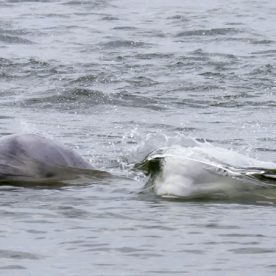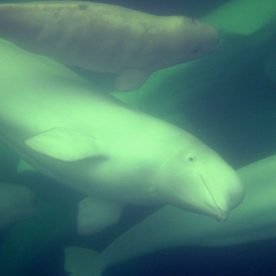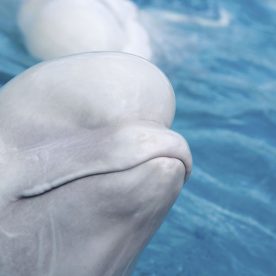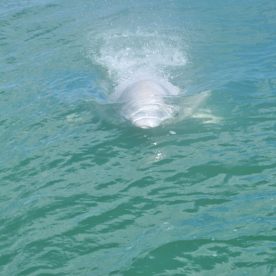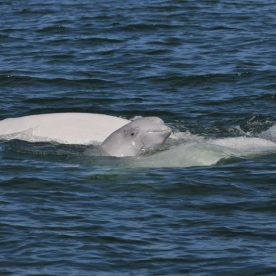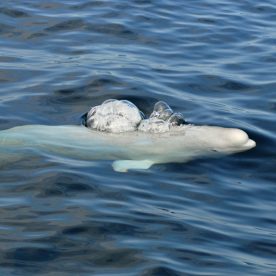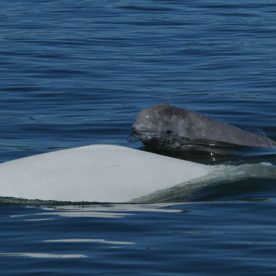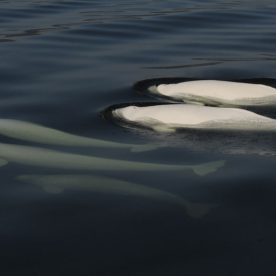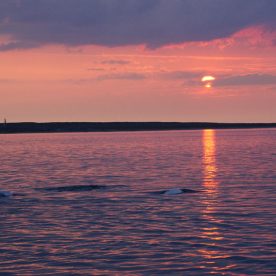Description
With its pure white skin and prominent, bulging forehead, the beluga whale is easy to spot. Beluga actually means ‘the white one’ in Russian. However, only adult belugas are white; calves are born brown or dark grey and gradually pale to become totally white between six and eight years of age.
Beluga whales have stout bodies, well-defined necks and a disproportionately small head. They have thick skins, short but broad paddle-shaped flippers, and sharp teeth. Unlike other whales, the beluga doesn’t have a dorsal fin. Belugas average 3 to 5 metres in length and weigh between 500 and 1,500 kilograms. Male whales have a marked upward curve at the top of their flippers.
Unique characteristics
 The St. Lawrence beluga represents the southern limit of the species’ worldwide range. All belugas are warm-blooded, air-breathing mammals, and all sport a layer of blubber between 2.5 and 9.5 centimetres thick beneath the skin. This fat serves as both an energy reserve and an efficient insulator that helps maintain body temperature in frigid waters.
The St. Lawrence beluga represents the southern limit of the species’ worldwide range. All belugas are warm-blooded, air-breathing mammals, and all sport a layer of blubber between 2.5 and 9.5 centimetres thick beneath the skin. This fat serves as both an energy reserve and an efficient insulator that helps maintain body temperature in frigid waters.
Belugas are very vocal animals, making a cacophony of sounds that range from high-pitched whistles to low, repeated grunts. The sounds are probably used for communication. For example, researchers have observed that squawks are emitted with more frequency when belugas are alarmed.
Range
This beluga lives—as its name suggests—mainly in the St. Lawrence River. Specifically, it is found in Battures aux Loups Marins (about 100 kilometres downstream from Quebec City), and in the Gulf of St. Lawrence (from Natashquan to Sept-Iles along the north shore, and from the Baie des Chaleurs to Cloridorne along the south shore). Individual beluga whales are occasionally found off the north shore of New Brunswick and in the Saguenay River from Chicoutimi to Saint-Fulence.
There are five groups of beluga found in Canadian waters, including the St. Lawrence River population. The other four populations are: the Cumberland Sound population, which is threatened, Eastern High Arctic/Baffin Bay, which is of special concern, and both the Ungava Bay population and the Eastern Hudson Bay population, which are both listed as endangered.
Feeding
Belugas also have a well-developed sense of hearing and refined ability to detect objects by sound. Called echo-location, this natural sonar is important to a species that lives a good part of its life in dark waters. At depths greater than 100 metres, there is virtually no light and belugas have been seen to make frequent dives to depths of several hundred metres. Visibility in water can be further reduced by silt runoff in river estuaries. To navigate and catch prey, belugas use a series of clicking sounds that bounce off fish and other objects in the water. The resulting echoes enable the belugas to build an accurate picture of what’s around them.
Breeding
Age & Breeding
Ages of beluga whales, and many other wild mammals, are determined by counting growth layer markings in their teeth. For years it was thought that belugas were unique among mammals because it had previously been accepted that two growth layers represented one year of growth. New scientific evidence published in 2006 rejected that interpretation and concluded that one growth layer actually represents one year of growth.
In the wild, belugas can live for 75 years or more. Males reach sexual maturity at 12 to 14 years, while females become sexually mature from 8 to 14 years of age. Belugas breed about every three years, between April and June. A female gives birth to one calf (about 1.5 m long) around July or August, after a gestation period of 14.5 months.
Beluga whales travel in pods of two to 10 whales, although larger pods are not uncommon.
Conservation
Excessive hunting—largely between 1880 and 1950 (when the 400-year Beluga fishery was at its most intensive)—has depleted whale numbers severely. Although the St. Lawrence beluga has been officially protected by the Canadian Fisheries Act since 1979, there has been no noticeable recovery in the population.
A number of factors are thought to contribute to the St. Lawrence River beluga’s failure to thrive. Pollution levels in the river are high. Dredging, shipping, industrial activity and environmental pollution have also resulted in a decline in habitat quality and contamination of food supply.
High levels of traffic—commercial and recreational—on the waterway have led to more frequent collisions with boats and exposure to significantly higher numbers of oil spills, further affecting the species’ survival. Finally, it has been suggested that the large and growing recreational whale-watching industry may have a negative impact.
The St. Lawrence beluga whale population is listed as threatened and protected under the Species at Risk Act (SARA). The whale is also protected under a number of other Acts, regulations and agreements.
A recovery plan for the St. Lawrence beluga whale was published by DFO in 1995. The long-term goal of the plan is to recover the beluga population to a point where the whale is no longer threatened by natural events or human activities. Ongoing research and monitoring activities include a study of the genetic structure of the St. Lawrence belugas to assess genetic variability and consequences of reduced population size. Data from this study will be used to help draft conservation and management strategies.
The Habitat Stewardship Program for Species at Risk (HSP) has funded a number of recovery and awareness projects.
- The Réseau d’observations des mammifères marins (ROMM)—a marine mammal ecowatch network—has developed a network of cruise and excursion operators to gather marine-mammal data.
- In the summer of 2000, a campaign was conducted to raise the awareness of recreational boaters in prime whale-watching areas.
- The Groupe de recherche et d’éducation sur les mammifères marins (GREMM) hopes to establish an action network to assist marine mammals in difficulty. The network will improve our ability to respond to cases of entanglement and reduce whale bycatch mortality in the Gulf of St. Lawrence and the St. Lawrence estuary.
Beluga whales will get the protection they need only if all Canadians work together to reduce threats. Find out more about beluga whales and be aware of man-made threats. Do your best to reduce these threats wherever possible to better protect the whales’ critical habitat. Get involved with the Habitat Stewardship Program for Species at Risk (HSP) or another conservation organization.
Resources
Online Resources
Department of Fisheries and Oceans Canada, Underwater World, The Beluga
Parks Canada, Species at Risk, The Beluga (St. Lawrence Population)
Species at Risk Registry, The Beluga (St. Lawrence Population)
Text:
Department of Fisheries and Oceans Canada with background information provided by Environment Canada in 2004.
Photos:
Christina Craft/www.naturestocklibrary.com




